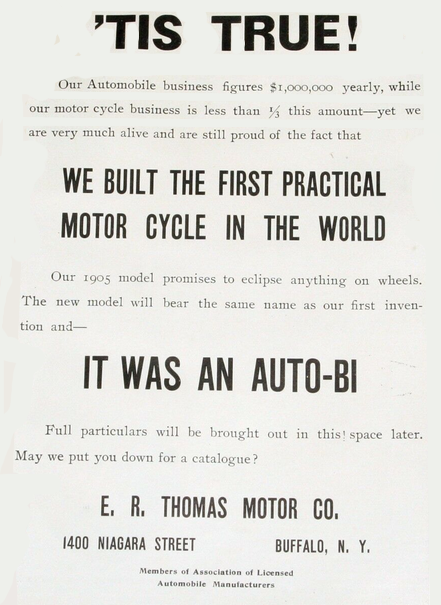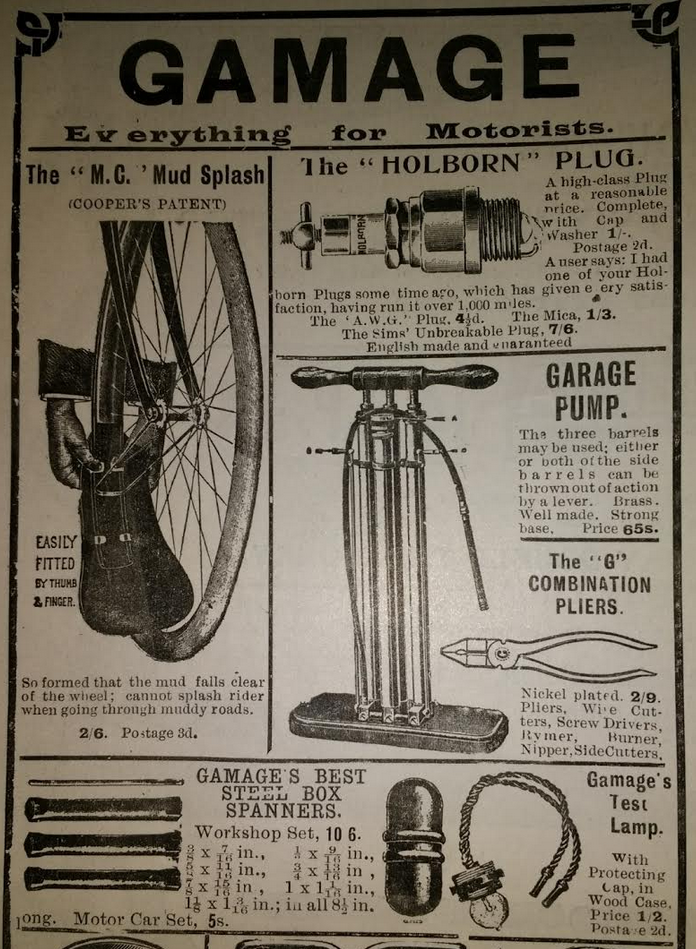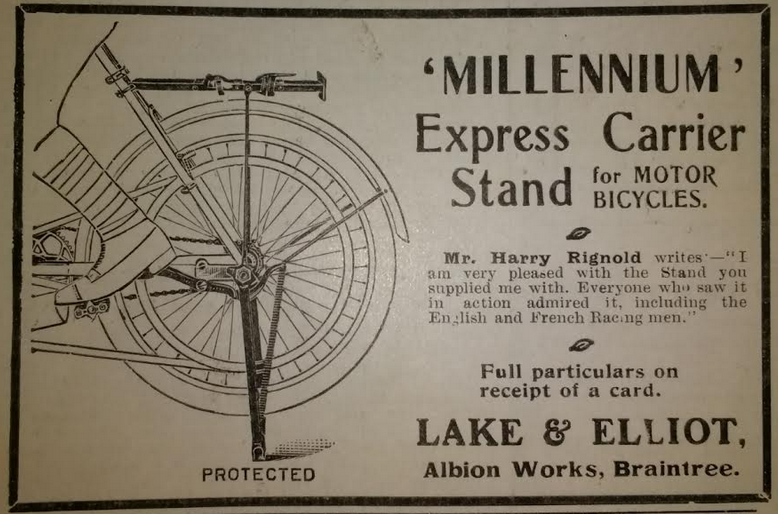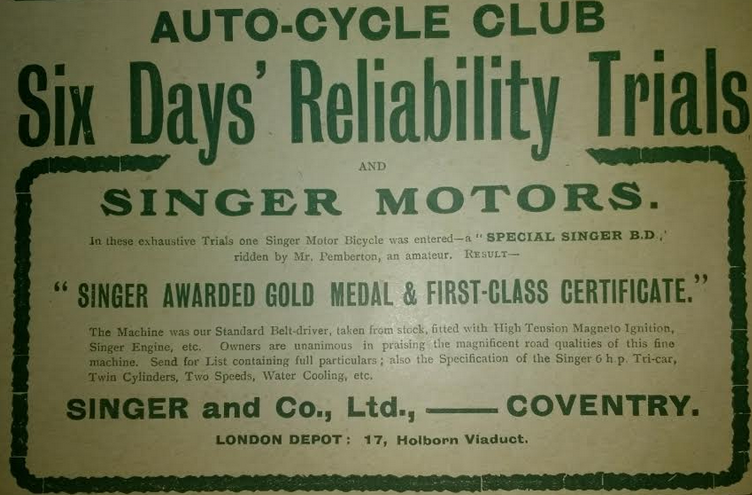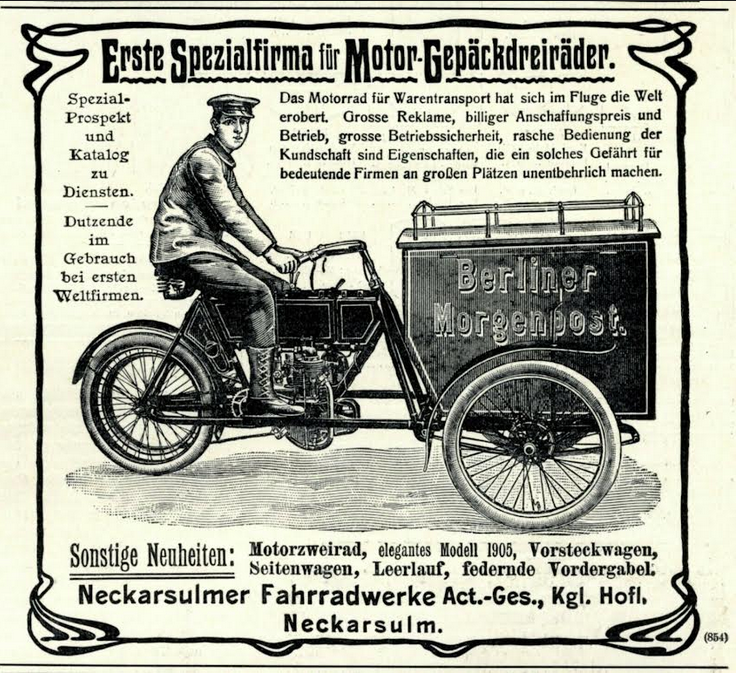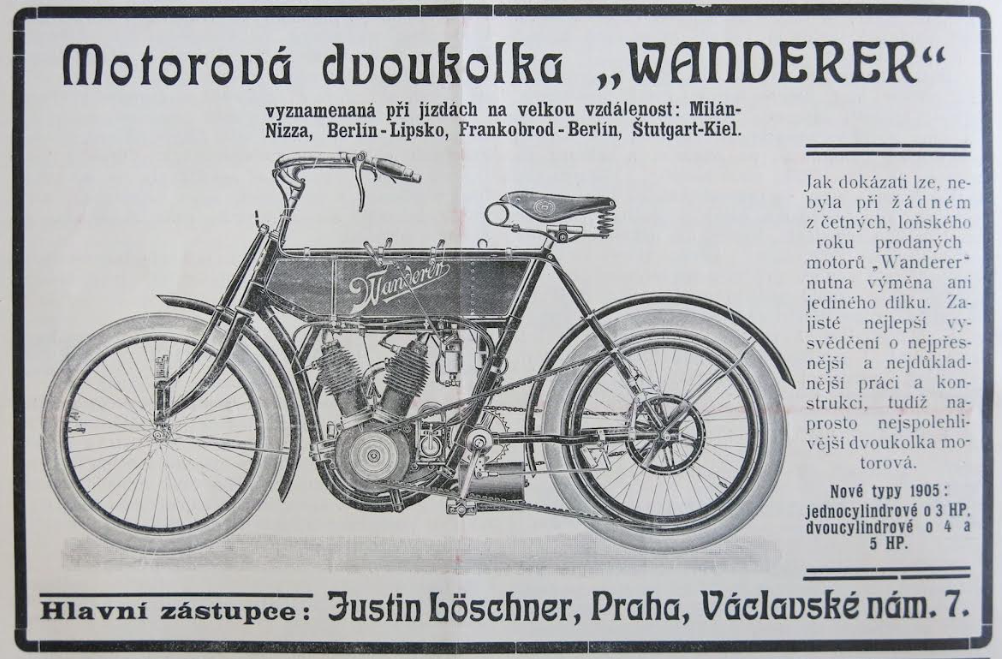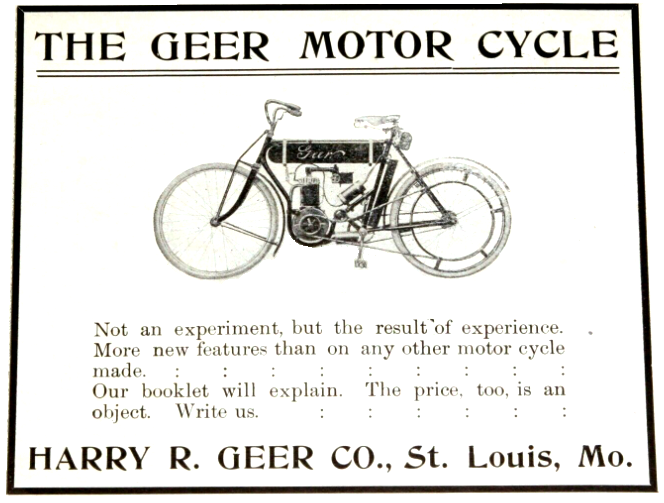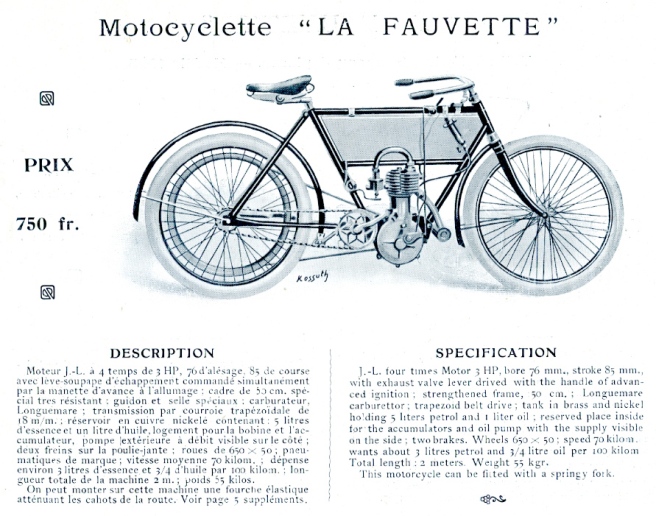“WE FAILED TO FIND a single motor cycle at the Stanley Show fitted with a surface carburetter, the spray having at last asserted its undoubted superiority. There were no ‘giraffe’ types of motor cycles exhibited, all having low frames with 26in. wheels. Some makers had even gone to the extreme and fitted 24in wheels, which, however, would not be comfortable unless fitted with large-diaimeter tyres or a spring frame.”

THE FICM RULES FOR THE COUPE INTERNATIONALE make interesting reading: note that the bikes had to work as pedal cycles; silencers didn’t have to silence; the 50kg weight limit was clearly seen as impracticable.—and the organisers were taking vandalism seriously: “1. The auto-cycle must not weight more than 50 kilos empty, that is without fuel, paraffisn, accumulators, tools, spare parts, and luggage. An allowance of 3 kilos is made for machines fitted with magnetos. 2. The auto-cycle mushst be entirely, and is every part, constructed in the country of the Club which they represent (in this case Great Britain and Ireland). 3. Machines must be finished with two brakes, either both at the back, or one at the front one at the back.. 4. Silencers (which may be so in appearance only) must be fitted. 5. Every machine to have pedals and chain or cardan shaft capable of propelling it without the aid of the engine. (It has been explained that these need only be sufficient to propel the machine for short distances, and their exclusive use throughout controls will not be enforced this year as heretofore.) 6. The cycles must be ridden by members of competing Clubs, or of Clubs recognised by them (in this case Auto-Cycle Club). 7. The race shall be over a road in road a single stage of a distance of from 250 kilometres to 350 kilometres at most. This distance can be selected from town to town, or broken up into going and returning runs or circuits, provided that each journey shall consist of not less than 40 kilometres. Note: The most elaborate precautions as to nails on the course will be taken this year. The course will be guarded by the military, swept on the eve of the race, and guarded all night be one cyclist and one policeman patrolling every kilometre.”
THE FIRST TWO BIKES HOME in the FICM’s international motor-cycle cup race were Laurin & Klements, made in Bohemia which is now part of the Czech Republic. L&K would later be acquired by Skoda so, not surprisingly, the victory has gone down in Skoda’s official history: “…the unofficial world championship took place 50 kilometres south-west of Paris in the small town of Dourdan. For the peak of the motorcycle racing season at the time, the organisers had mapped a 54km circuit which had to be completed five times. It also included three so-called neutralisation sections—in these stretches, the drivers had to push their machines with the engine turned off and hope that they would start up again afterwards. In 1905, the strongest national teams of their time competed in this international competition. In the hopes of representing Austria-Hungary, two riders with motor cycles from Laurin & Klement, František Toman and Václav Vondřich, had entered themselves into a qualifying race in Pacov, Czech Republic. Eduard Nikodém on a Puch came third in the group. The brands Ariel, Matchless and JAP competed for Great Britain; the French two-wheelers

came from Griffon and Peugeot; while Germany sent three Progress motor cycles to France. The strict regulations stipulated that in addition to all the essential components, the tyres also had to come from the respective country of origin. Tyres only lasted for short distances at that time, and the riders themselves were responsible for repairing them. The Laurin & Klement team arrived well prepared: in trials the year before, they had covered the challenging track with nails, which made tyre failures even more likely. And so Vondřich started the race with a heavy leather bag strapped to his back. It contained all the necessary tools and spare parts but also earned the Czech the nickname ‘The Travelling Blacksmith’ from the spectators. Despite the additional weight and higher centre of gravity, Vondřich with his two-cylinder L&K CCR quickly caught up with the previous year’s winner, Léon Demeester, who was in the lead. On the fourth lap, after 246km, the Czech…took the lead. At the finish line, he was more than eight minutes ahead after 3hr 13min 17sec, before the Frenchman was eliminated from the classification due to an illegal rear wheel change. As a result, František Toman moved up one place to make a perfect double victory for Laurin & Klement. Only three of the 12 participants managed the full distance.”
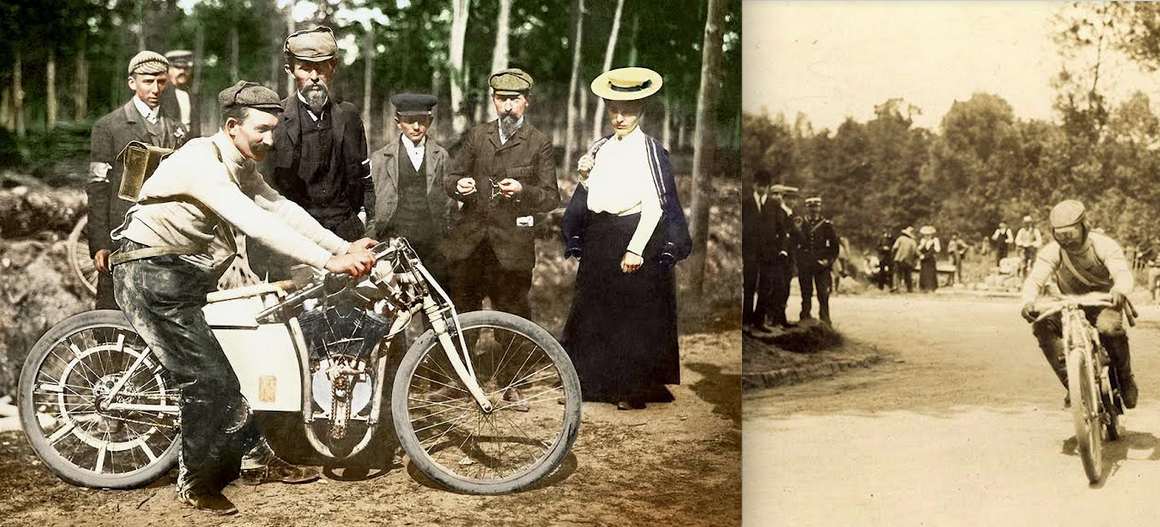
TO GET ROUND the British ban on road racing the ACC staged selection trials for the Coupe Internationale on the Isle of Man as part of the Gordon Bennett car races (the secretary of the Automobile Club’s cousin was Lord Lieutenant of the Island). Seven bikes built to comply with the Continental 50kg racing limit started the high-speed reliability trial. Only two made it to the end but a team of three was selected. A local newspaper reported: “It being necessary to open the roads to the public at eight o’clock, the race commenced at three, when a large number of people assembled at Quarter Bridge to witness the start. There were 17 entries, but only seven faced the starter. The course was that of the Gordon-Bennett motor tests, with the omission of Snaefell, which is both difficult and dangerous for motor cycles. The official result was declared to Campbell, on an Ariel machine, first, HA Collier, on a Matchless, second, and Franklin, on a JAP, third, providing the last-named can satisfactorily explain that stoppage made was not due to defective machinery.” Some years later ACU secretary Fred Straight shared his memories of the day: “For some reason or other the start had been fixed for 3am. The weather at that time, however, was very hazy, and it was decided to delay the start for half an hour. One of the conditions was that machines should not exceed 110lb in weight [in line with the Continental 50kg limit], and it was amusing to see the riders when their machines were put on the scales and found to be overweight filing away all possible parts in order to reduce the weight. The rubbers were taken off the pedals, side plates discarded, holes bored in the pulleys and belt rims; in fact, the majority of machines were so weakened that it was not to be wondered at that only two completed the course, viz, JS Campbell (6hp Ariel) and HA

Collier (6hp Matchless), the former winning by 1min 16sec over a distance of 120 miles, which was covered in 4hr 9min 36sec. Barnes was one of the competitors in this race. He made a very brilliant start from Quarter Bridge, darting away like a shot out of a gun, but we saw nothing more of him, and it was reported that at the first bad corner he was travelling too fast to get round, so went straight on and in at the door of a cottage.” Notable among riders who didn’t make the team were Charles Jarrott (6hp JAP), Charlie Collier (6hp Matchless), Freddie Barnes (Zenith), Adrian Conan Doyle (3hp Roc), son of Sir Arthur, who had a financial interest in Roc manufacturer AW Wall, and “Rev BH Davies”—Ixion, of course—on his 8hp Westlake. And just for fun, here’s Ixion’s recollection of the event: “We began preparations in good time, and the eliminating trials to choose a team of three were run off in the Isle of Man on May 29. Nineteen machines were entered, most of which were big twins, despite the 108.5lb weight limit imposed by the French. GA Barnes actually produced a V twin measuring 94x100mm [1,387cc] but it was almost unstartable, and when it got going generally split its pulley or tore the spokes out of its back wheel. Nobody realised that reliability is the first essential in racing; the machines were far too flimsy, and the engines much too big. Barnes even got a fretsaw and cut a lot of leather out of his tiny saddle. At the last moment the course was altered, as the machines could not manage the two hairpins on the climb from Ramsey up Snaefell. In the race a very poor standard of reliability was shown. Only two machines (Campbell’s Ariel and HA Collier’s Matchless) completed five laps before the roads were opened at 8am. The speed was rather less than 30mph. Franklin and Rignold (reserve) on JAPs were chosen to complete the team. Needless to say, we were completely outclassed in the International, which was won by the Austrian Vondrick at more than 50mph.”

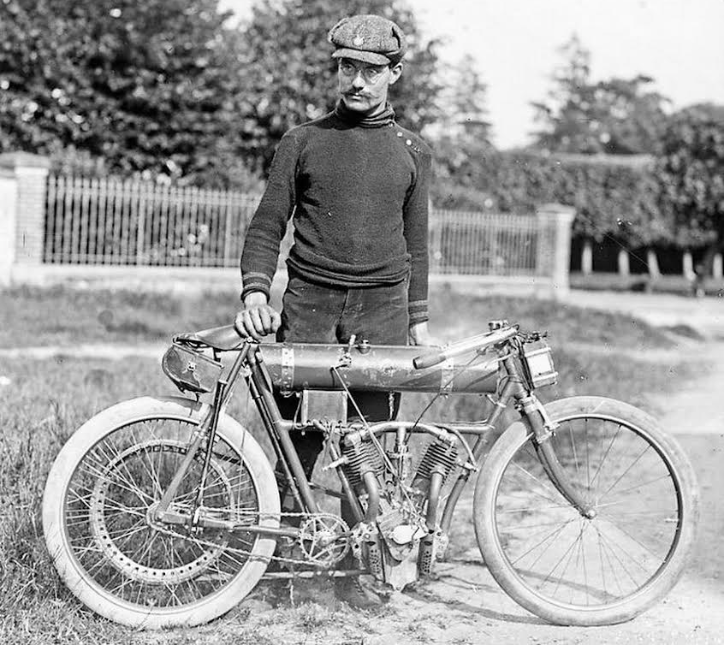

FROM 1902-1909 MOTOR CYCLING ceased production, leading to The Motor Cycle’s masthead slogan, “Established in 1903 and for six years the only paper solely devoted to the pastime”. But Temple Press didn’t ignore motor cycling; The Motor took an interest, as had Illiffe Press’s Autocar before the arrival of The Motor Cycle. So we must thank The Motor for the following: “Alexander Anzani, the Italian expert, who recently won the [first] world’s motorcycle championship at Antwerp [on an Alcyon powered by a 330cc Buchet single-cylinder engine he developed himself] accomplished a really marvellous record ride at the Parc des Princes track, Paris, on Saturday last week, by covering 58 miles 489 yards in the hour, and 100 kilometres (62 miles 246 yards) in 1hr 14min 14.4sec, as against the previous bests of Joseph Guippone of 56 miles 266 yards and 1hr 6min 36.4sec respectively. It will therefore thus be seen that a mile a minute for 60 consecutive minutes is within the bounds of possibility, even on a small motorcycle weighing under 50 kilogrammes (110lb), while in endeavouring to reach this end Anzani is actually reach this end Anzani is actually reducing the cylinder capacity, his record ride being accomplished on 90x90mm, whereas with the identical engine 90x110mm dimension the most he could get out of it last year was about 54¾ miles. Unfortunately, the weighing in after the record, Anzani’s Alcyon, which was fitted with a Buchet engine and Dunlop tyres, was found to be a trifle over 50kg, and so the record for this latter type of machine still stands to the credit of Guippone, but as the world’s bests, Anzani’s times are well ahead of previous figures. During the past month the Italian has been experimenting with the engine, and told the writer that when he summoned the official chronométreur new times would be recorded, and this statement be thoroughly confirmed. It is generally the second time of asking that these marvellous rides are completed, and Anzani’s case proved no exemption, for in his first attempt the oiler did not work satisfactorily; but after this had been adjusted everything went like clockwork…Anzani’s wonderful ride of over 58 miles in the hour is a triumph for the light motor-bicycle.”
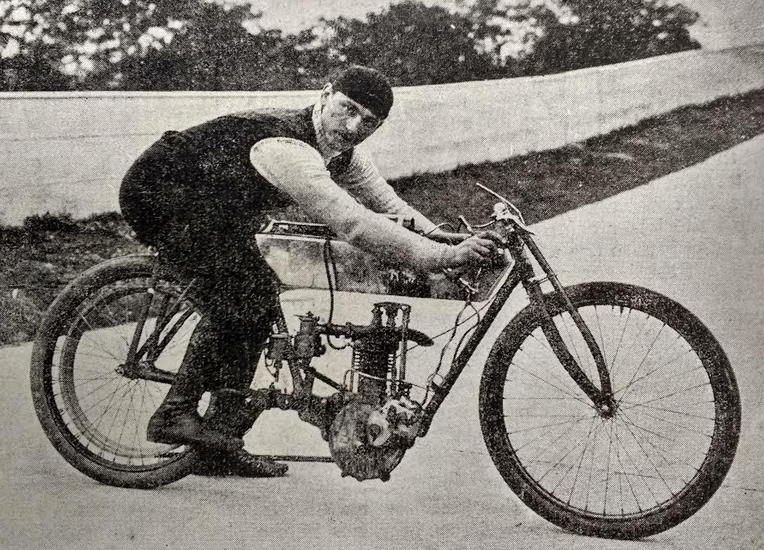


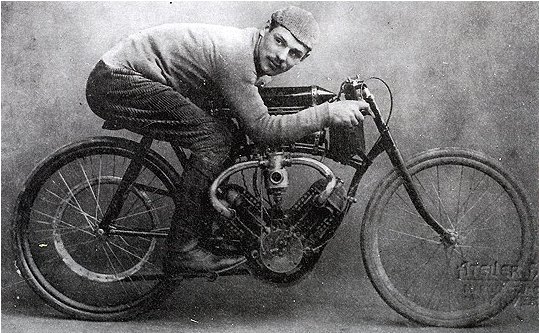
THE CHATEAU-THIERRY ‘UPHILL RACE’, now in its 4th year, was paired with the similar late-season hillclimb at Gaillon, with cups awarded for aggregate scores. The event was open to touring and racing vehicles from light motorcycles to trucks, in 15 classes. On the day before the race rain made the roads slippery, and the stewards noted that the S-curve after the first straight kilometre had become too dangerous for the racing cars so they decided on standing starts in both races (kilometre and mile) except for the ⅓-litre bikes, which ran the flying mile. Peugeot entered Cissac, Giuppone and Champoiseau in the two ⅓-litre lightweight events. In the sprint mile race, the eagerly awaited Peugeot/Alcyon confrontation was won by Paugeot, with Giuppone beating the previous record set by Collomb (Magali) by three seconds. In the ⅓-litre class victory went to Anzani (Alcyon), followed by Contant (Quentin) and Giuppone on (Peugeot) .


JOSEPH BARTER’S LIGHT Motors, which had already produced a conventional single-cylinder engine to power a bicycle, developed a 200cc in-line flat twin marketed as the Fee (French for Fairy) which was soon anglicised to Fairy. It was (probably) the first flat-twin.

INDIAN CAME UP with a 500cc V-twin. It was a good year for V-twins; they also came from NSU of Germany, Puch and Styria of Austria—and Indian’s compatriot Glenn Curtiss. He put his twin to good use by riding it round the one-mile Syracuse dirt track in exactly 61 seconds to set the latest in a series of records.
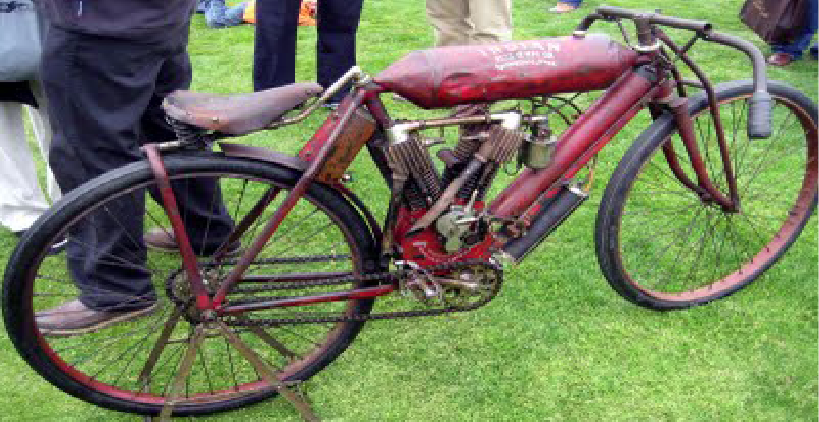


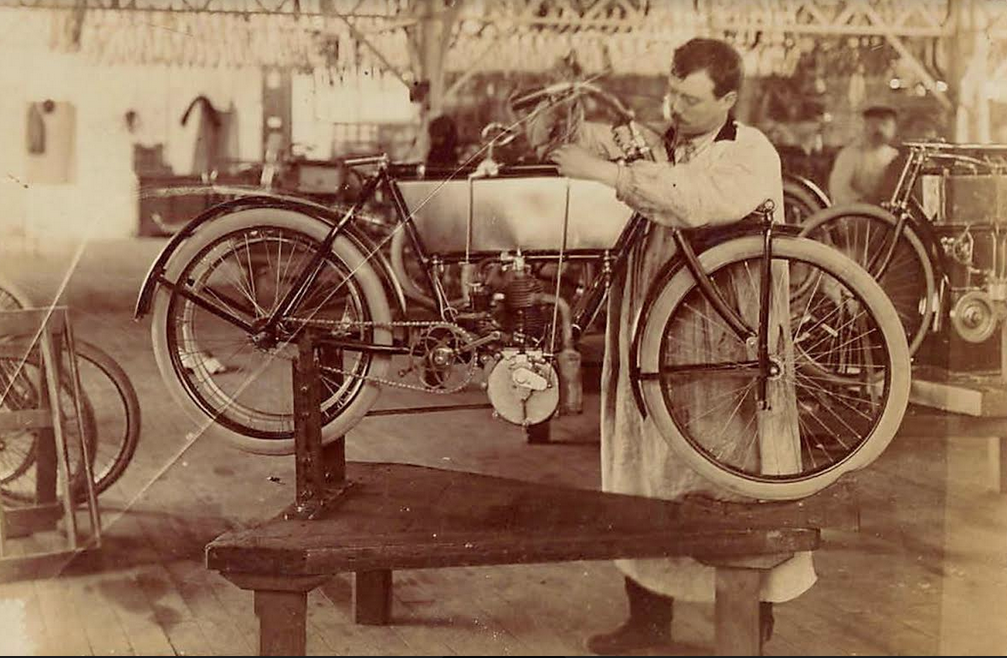


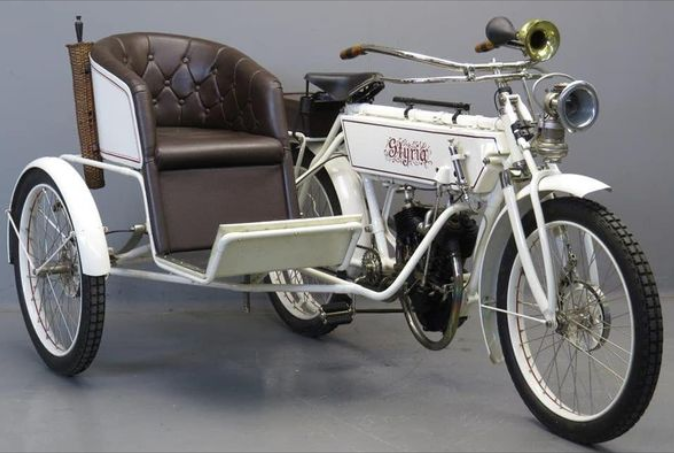

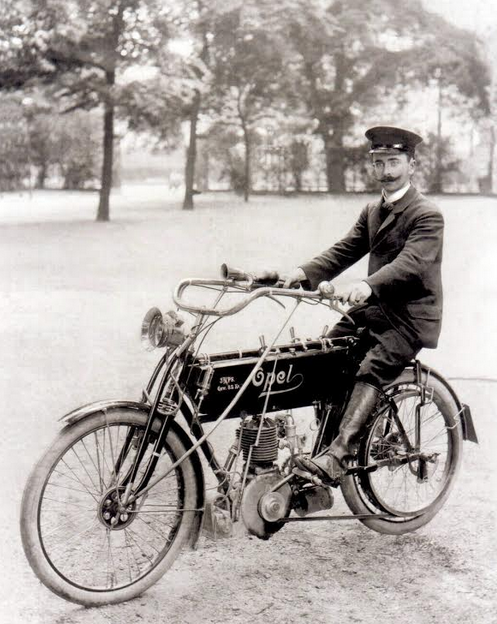
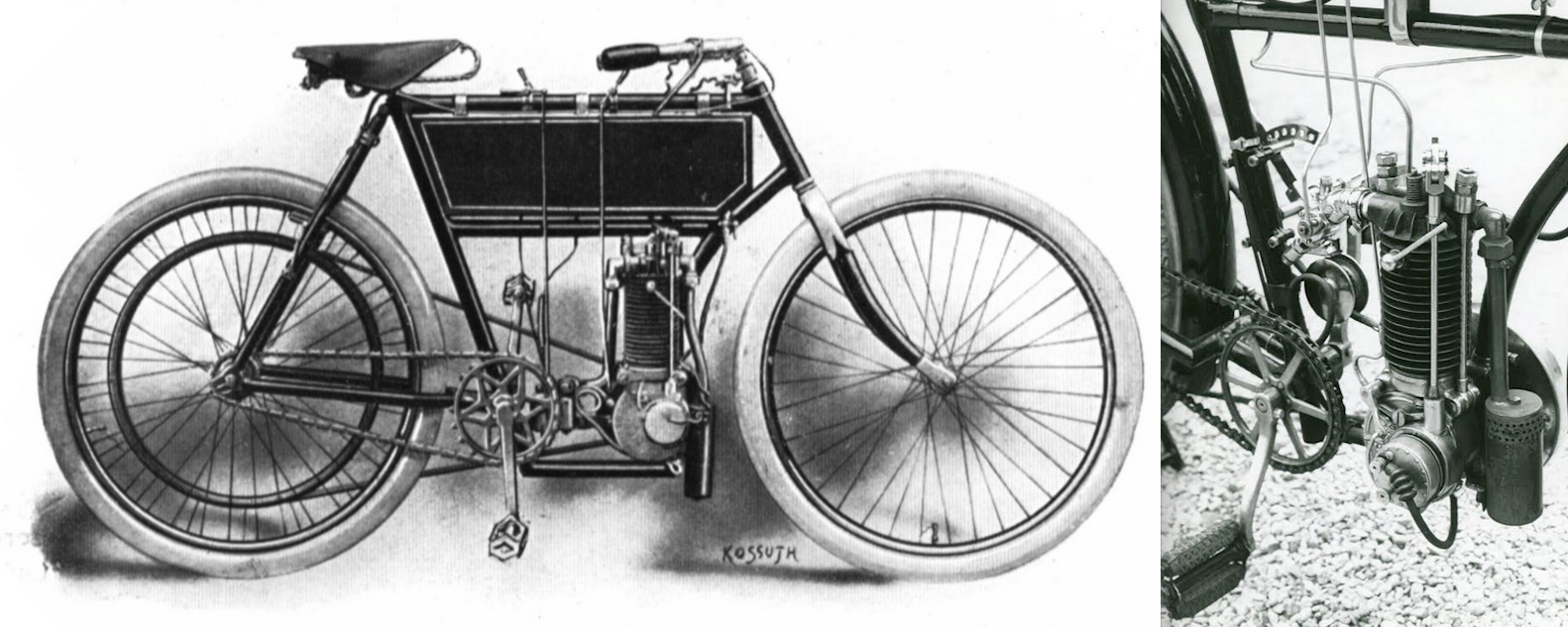
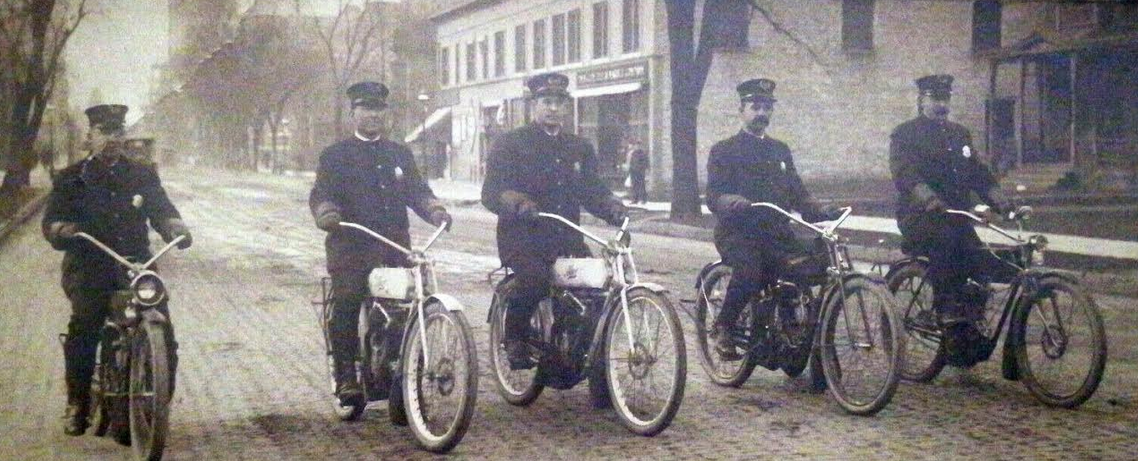

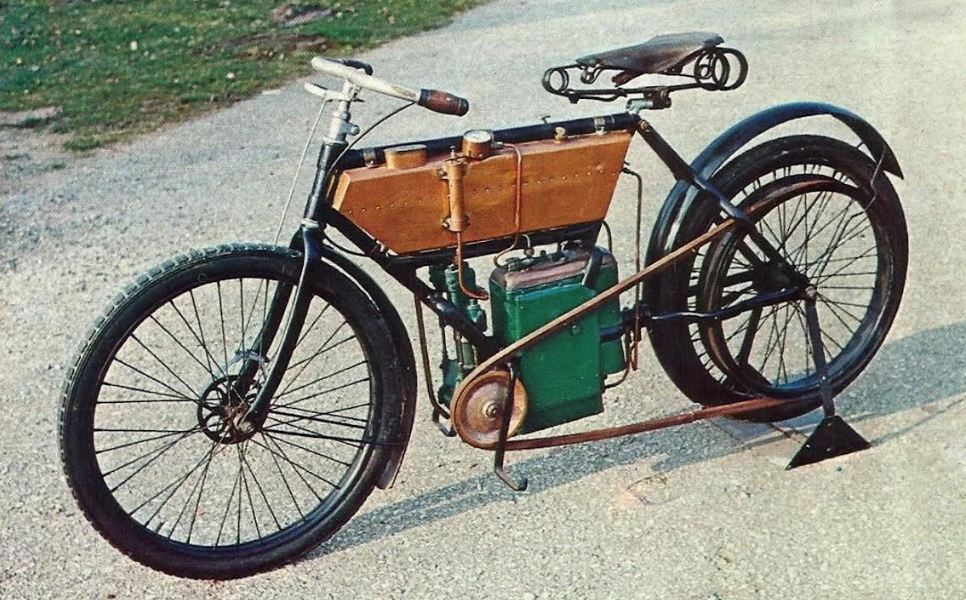
THE AUTOMOBILE CLUB of Great Britain and Ireland staged a week of races on Brighton seafront after local resident Sir Harry Preston persuaded the local council to lay a motor racing track using the newly invented tarmac between the Palace Pier and Black Rock. [Since 1909 this stretch of road has been called Madera drive. It is still the home of the Brighton Speed Trials and was the destination of The Sunbeam MCC’s Pioneer Run until 2020 when it switched to Shoreham airfield for safety reasons.] Here’s a contemporary acount: “Some wonderful speeds were accomplished by motor cars and motor cycles at the opening race meeting held on the new straightaway Automobile Racing Track laid down on the Esplanade at Brighton, England. The track is 1.25 miles, with a special surface composed of tarmac, which is said to give a perfect surface for automobile racing. Vey fast times were established by the huge racing cars, but…the motor cycle more than held its own. The motor cycle honours were carried off by H Cissac and H Rignold, both of whom drive 14hp twin cylinder Peugeot cycles weighing under 110lb. The former crack won the open Motor Cycle Mile Race from a flying start in 49.6sec. During the mile he covered a flying kilometre in the astounding time of 26 seconds (World’s Motor Cycle Record) equal to a speed of 86mph. Subsequently in a record attempt Rignold converted a flying mile in 46.2sec, world’s record. Cissac also succeeded in covering a mile from a standing start in the wonderful time of 52.2sec, the previous best being 64sec…The most interesting items during the Motor Carnival, which spread over four days, were two matches between Rignold on his motor cycle and the Hon AL Guinness on his 100hp Darracq car. The distance was over a kilometre from a standing start. The event created great excitement. At the start the car, with running engine, jumped into a high speed at once, gaining 20 yards before Rignold had his motor firing. In 30 yards the motor cycle was travelling at 50mph. He gradually crept up to the flying Daracq, but faile fot give away the 20 yards lost at the start. Time 35.8sec, world’s record. A similar match was held between Cissac and JE Hutton on a 120hp Mercedes car, resulting in a repetition of the first match. Hutton won by a few yards in a second slower than that accomplished by Guinness. The carnival drew enormous crowds and was a great success.”



LE TOUR DE FRANCE POUR MOTOCYCLETTES (as distinct from the pedal-pushing offshoot) was staged by the Autocycle-club de France and the newspaper Les Sports under the patronage of the Automobile Club de France and the Touring Club de France. The nine-day time trial was promoted as “a 2,000 kilometre ordeal, the biggest and toughest that has ever been imposed on the motor vehicle…a colossal test”. Judging by the statistics that wasn’t entirely Gallic hyperbole—of seven riders in the 225cc class two completed the course; there were 38 starters in the popular ‘one-third litre’ 333cc class, and 14 finishers; and only one of the nine 500s completed the Tour. Here’s a taste of the action, courtesy of Les Sports’ sister magazine, La Presse. “Day 1, Paris-Auxerre-Dijon (319km), 5am-4pm: Pouring rain, wind, soggy and slippery roads. The bad weather continues to rage; it will make the task of the competitors in the Tour de France on motorbikes quite painful, and one wonders how these frail vehicles will even manage on the long and difficult route that has been imposed on them. [Best time] Tiercelin (Alcyon), 4hr 16min. Day 2, Dijon-Macon-Saint Etienne (250km), 6am-5pm: The day was better, the rain that had accompanied the riders from Paris to Dijon finally left them behind and if there were some threatening clouds at the start of Dijon, it was in superb weather that the finish was made in Saint-Étienne. Giuppone (Peugeot), 3hr 22min. Day 3, Saint-Étienne-Montélimar-Avignon (225km), 6am-3.30pm: Heavy rain and slippery roads, particularly on the ‘Côte de la République between Saint-Étienne and Bourg-Argental. All the competing machines showed extraordinary durability, and an example must be given, that of Mallet, to demonstrate this: he did, in fact, following a skid in the Côte de la République, an extraordinary somersault, which sent him tumbling down the embankment of a ravine about fifty metres deep. The man was unharmed and so was his mount, as they were both checked in the evening at the final stage. During the second part of the stage, from Valence to Avignon, the rain was still falling! Not for a moment did it show mercy to the Tour de France riders, and it was in the rain that they arrived in Avignon, whose city walls, despite the weather, were covered with people. There is no need to say that the event organised by our colleague, Les Sports, is a colossal success and fascinates all the towns and regions through which it passes. Day 4, Avignon-Marseille (110km) 7am-noon: Overcast and dry, mistral wind at the back. Day 5,

Marseille-Nîmes-Narbonne (279km) 6am-4.30pm: Mistral on the side…Yesterday, the fourth day of the Tour de France motorbike race, was relatively a day of rest for the competitors; the course, in fact, which was covered in a single stage, was only 110km long, and if the sun of the Midi did not deign to join in, at least the mistral, a good boy, had the sense to blow all the time at the competitors’ backs, thus coming to their aid and notably increasing their speed. All the competitors, that is to say the 23 motorbikes that arrived in Avignon the day before and left from this town in the morning, reached Marseilles without any trouble. No accidents, only two incidents: Faivre, who ran over a dog, and Lemétais, who hit a level crossing barrier. The two robust little machines resisted wonderfully and their riders were able to continue on their way, after examining their mounts, as if nothing had happened…Having set off from Marseille, the valiant competitors of the Tour de France found the mistral again from the very first turns of the wheel; but, this time, instead of helping them, this damned wind started to take them by the scruff of the neck, taking them off their saddles at times and almost throwing them into the ditches. This is how Mignard smashed his engine against a badly placed paving stone, which forced him to retire. It was Nîmes (131km) that was the goal of the first stage of the fifth day. To describe the enthusiasm of the people of Nîmes is almost impossible; it was amidst cheers, ‘Vive Les Sports! Long live
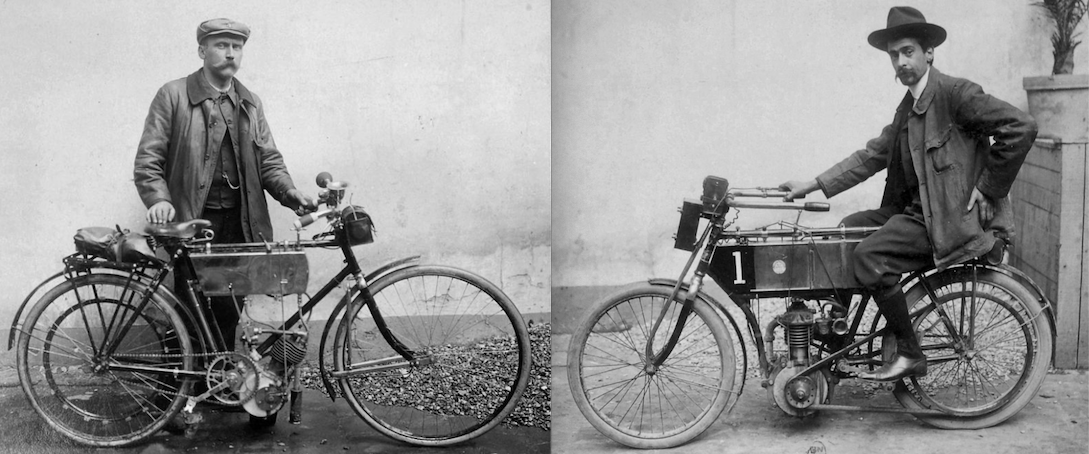
Thomas! Vive Cissac!’ etc, that the riders arrived, for in Nîmes, people are very sports-minded and follow with passion the reports of the great events. Narbonne (279km) is the goal of the stage of the fifth day. The control, set up in the Capitole café, was invaded well before the time fixed for the opening by a huge, turbulent crowd which shouted, gesticulated, discussed and which, as all along the route, snatched up the issues of our colleague Les Sports, to read the details of the race of which they were spectators. The first arrivals, grey with dust, are enthusiastically cheered and accompanied to the garage, where the machines must spend the night. Day 6, Narbonne-Toulouse-Agen (273km), 6am-4.30pm: Dry weather, dry roads. Narbonne woke up earlier than usual to celebrate one last time before their departure the courageous competitors of the great Tour de France for motorbikes, organised by our colleague Les Sports, with a care which makes this competition one of the most interesting and remarkable manifestations of the automobile. Of the twenty-three riders who left from Marseille, only two withdrew and the 21 others got into the saddle at seven o’clock in the morning to set off for Toulouse, the goal of the first stage of this sixth day. The weather was favourable, the roads dry and smooth, and our men happily covered the 150km that separated them from the capital of Languedoc. There, indescribable ovations were to receive them; it was necessary to have an important service of order to maintain the crowd of enthusiastic spectators, who all wanted to see the competitors of the Tour de France on motorbikes. At the exit of Toulouse, Messrs Audistère and Richard, official timekeepers of the Automobile-Club de France, always faithful to their post, took the times of the level kilometre, which Giuppone won in 51⅖sec which set the world record for motorbikes of one third of a litre on the road. When one considers that Giuppone’s machine has just run for six days in a row, with a daily average of 250km, one can be really proud of the progress that French industry has made in this marvellous little motorised machine that is the motor cycle. Day 7: Agen-Bergerac-Limoges (271km), 6am-4.00pm: Beautiful weather, dry roads. Day 8: Limoges-Châteauroux-Orléans (263km), 6am-4pm: Strong wind, freezing cold, bad roads. The seventh stage took place yesterday in splendid weather. The world record for the kilometre was beaten by Thomas, in 48⅘sec, ie at more than 70 per hour. Early in the morning, the competitors went to the central garage, where the start was to take place, and checked their machines one last time before setting off. As every day, the Phoenix-Trimo tri-car starts first at 6 o’clock in the morning, followed at 6.30am by the quarter-litre motorbikes and at 7 o’clock by the third-litre motorbikes. Nineteen riders presented themselves under the orders of the starter. Le Métais, who was unwell, retired. The stage from Limoges to Châteauroux (124km) was, according to the unanimous opinion of the valiant riders, the most difficult of all those they had ridden so far. The road was very hard and very uneven, which delayed their march somewhat. A violent wind and a bitter cold did little to increase the difficulty of this arduous journey. Out of 19 starters from Limoges, 17 arrived within the prescribed time limit. Only Faivre, on whom the jinx seems to be particularly strong, and van Hooydonk arrived after the expiry of these deadlines. Faivre punctured three times, and the English team nine times. The latter holds the record for punctures so far. Van Hooydonk’s team-mate is collecting nails that he wants to take to England as a souvenir of the Tour de France. Orléans, the goal of the penultimate stage, is a sporting city par excellence. Also, it is in front of several thousands of onlookers that the arrivals took place, in spite of the distance of the control installed at the octroi of the Manillère. All the competitors are in great spirits, with only 128km to go, and they will finally receive the warm ovations from the Parisians that are their due after this wonderful event. Day 9: Orleans-Ville d’Avray (128km) 9am-2pm. The Tour de France organised by the Autocycle-Club de France and the newspaper Les Sports is over. Seventeen competitors have completed the course, offering the best average regularity ever found in a competition. As this was the toughest competition ever attempted, it is easy to see the logical conclusion to be drawn. The motorbike had played a game that was all the bigger because it was more public. The
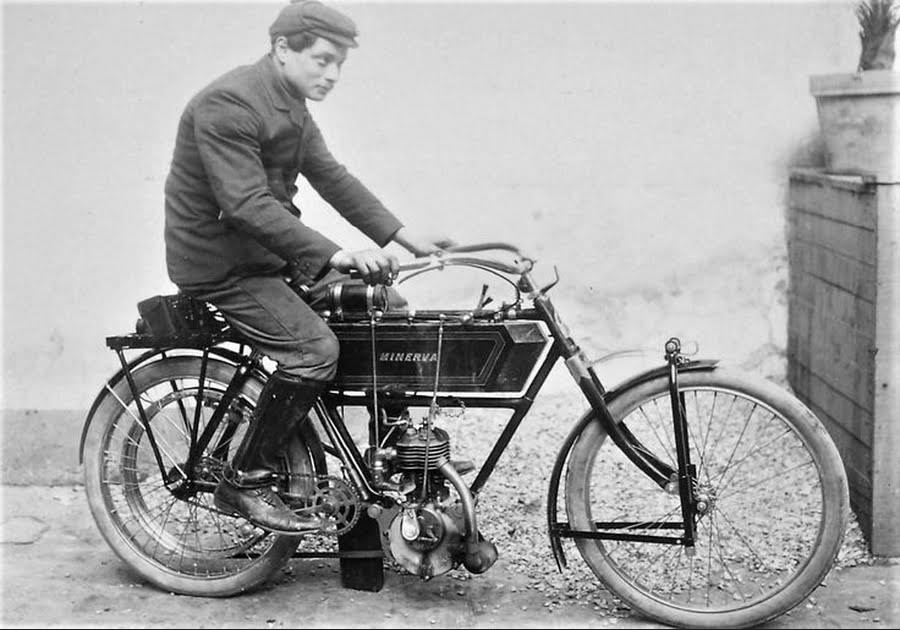
whole of France, and especially the thirty departments crossed, the 400 towns which had seen the…small squadron of motorcyclists parade by, followed this audacious attempt with an attentive mind, ironic at the beginning, enthusiastic at the end. It succeeded, even beyond what one could have wished. The motorbike, the small practical machine, because it is simple and cheap, won its grand touring licence in a week. It now has it; it is known that it can be counted on, and it has, as a result, won over to itself and to the cause of the automobile the innumerable armies of small purses. The final classification, naturally subject to the official approval of the committee, is as follows—333cc class: 1, Cissac (Peugeot), 1212 points; 2, Guippone (Peugeot), 1200; 3, Bucquet (Griffon), 1192; 4, Blatgé (Minerva), 1183; 5, Champoiseau (Peugeot), 1168; 6, Bonnard (Werner), 1151; 7, Schweitzer (Minerva), 1146; 8, Thomas (Magali), 1129; 9, Foulon (Brùneau), 1107; 10, Lepetit (Stimula), 1098; 11, Canèsse (Lamandière-Mauger), 973; 12, Contant (Werner), 953; 13, Platel (Stimula), 925; 14, Yourassoff (Peugeot), 883. 225cc class: 1, Dacier (Clément), 803; 2, Faivre (Terrot), 632. 500cc class: 1, van Hooydonk (Phœnix Trimo), 783. Thus ends the toughest endurance race to which motorbikes have ever been subjected. The classification of the Peugeot team provided an excellent indication for the choice of a real motorbike, a touring motorbike. It should be noted that in each of the nine stages it was Peugeot that held the lead, with Cisaac, Giuppone and Champoiseau, and if we consider that Cissac and Giuppone are first and second by twelve points, is this not the best proof of the regularity of the motorbikes of the great manufacturers of Valentigney? The times for the uphill kilometre were taken in the Côte de Dourdan, by Messrs Audistère and Richard, official timekeepers of the ACF. Here are the results: 1, Thomas (Magali) 1min 31⅗sec; 2, Giuppone (Peugeot), 1min 32⅗sec; 3, Cissac (Peugeot), 1min. 45⅕sec; 4, Schweitzer (Minerva), 2min 7⅕sec; 5, Canisse (Lamaudière-Mauger), 2min 7⅗sec; 6=, Bucquet (Griffon) and Bonnard (Werner), 2min 9⅕sec; 8, Champoiseau (Peugeot), 2min 10⅖sec; 9, Le Metais (NSU), 2min 13⅘sec; 10, Foulon (Bruneau), 2min 19⅗sec; 11, Blatgé (Minerva), 2min 25⅘sec; 12, Yourassoff (Peugeot), 2min 28⅘sec; 13, Lepetit (Stimula) 2min 30⅘sec; 14, Contant (Werner) 2min 51⅖sec; 15, Dacier (Clément), 3min 17sec; 16, Van Hooydonk (Phœnix-Trimo), 3min 21sec; 17, Faivre (Terrot), 3min 21⅕sec. The length of the climb…was 1km 350, including 200 metres of cobblestone after a difficult bend. There was a strong headwind.”

NOT ALL TWINS were of the V-persuasion. The Paris Show featured vertical twins from Werner and Bercley (a new Belgian marque) and a 363cc in-line four from FN with a Simms-Bosch high-tension magneto, shaft drive running through a frame tube, leading link forks and a drum rear brake.
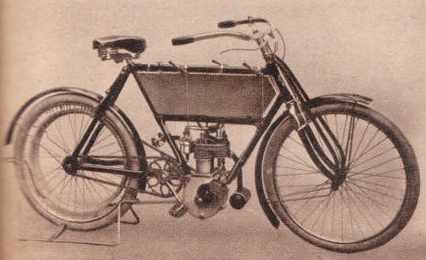

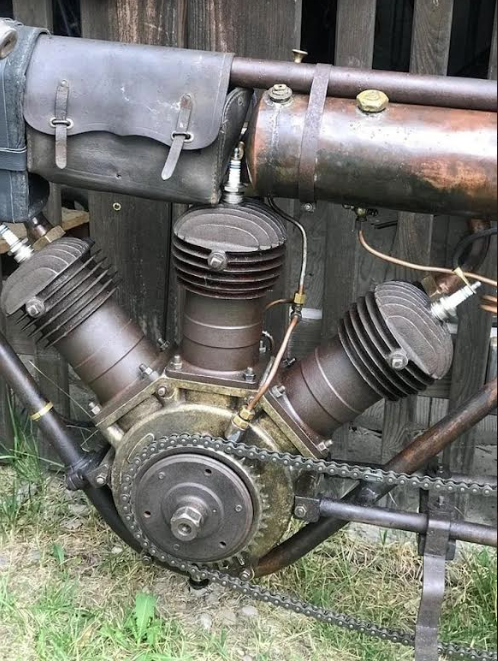

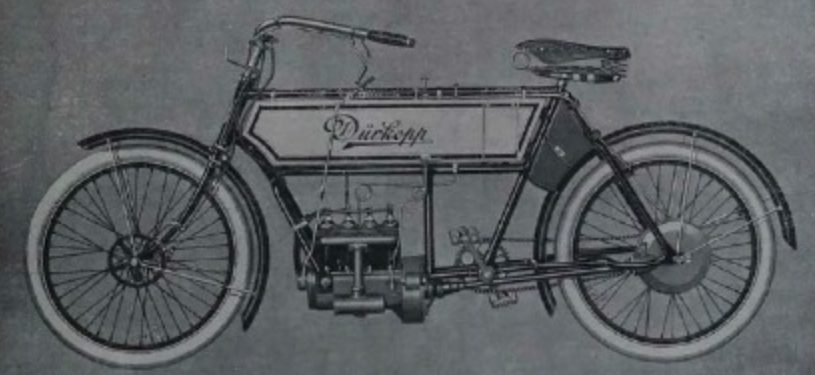

THE AUTOFAUTEIL DEBUTED with small wheels, an enclosed (427cc) engine mounted below the ‘fauteil’ (armchair) and an open frame – in essence the ancestor of the motor scooter.
SWISS ENGINEER ALFRED BÜCHI patented a “highly supercharged compound engine” incorporating an “axial compressor, radial piston engine and axial turbine on a common shaft”.Thepump was tyo be driven by exgaust gas so this marks the birth of the turbocharger. The idea of precompressing the air suppliedf to an engine was as old as the combustion engine—Gotleib Daimler had a go in 1885, as did Rudolf Diesel in 1896. Judging by Büchi’s drawings it would have worked too, but he was ahead of his time; superchargers would have to wait for the right fuel and materials.
THE FIRST SPEEDING FINE ISSUED in Western Australia resulted from speed limits drawn up by Perth City Council only weeks before: 4mph at crossroads, 10mph on three nominated streets and 15mph elsewhere. Arthur Spalding, the charge alleged, had “furiously ridden a motor-bicycle”; he was fined 18 bob with 2d costs.
THE LAUNCESTON MC was set up in Tasmania and it’s still going strong today—it controlled motor cycle sport on the island until the ACU of Tasmania took over in 1958.
THE AUTO-CYCLE CLUB, as Ixion noted some time later, “was beginning to wrest the reins of development fro the MCC” and staged a 750-miles Six Days Trial: 31 bikes started, 21 finished and six won gold medals. The course included Birdlip Hill which was scaled by one superman on a single-speed 5hp Ariel trike “which was forced up the long ascent by a determined rider with super leg muscles”. But two P&Ms astonished the competition by cruising up thanks to a two-speed transmission—”goggle-eyed men, lying purple-faced and panting by the hedges half-way up Birdlip, stared incredulously at the machines as they climbed steadily under their own power”. AJ Wilson, author of the seminal Motor Cycles and How to Manage Them, presented a prize “for the best performance in comparison with the total weight of the machine”. It was won by LM Young on a 2½hp Werner.
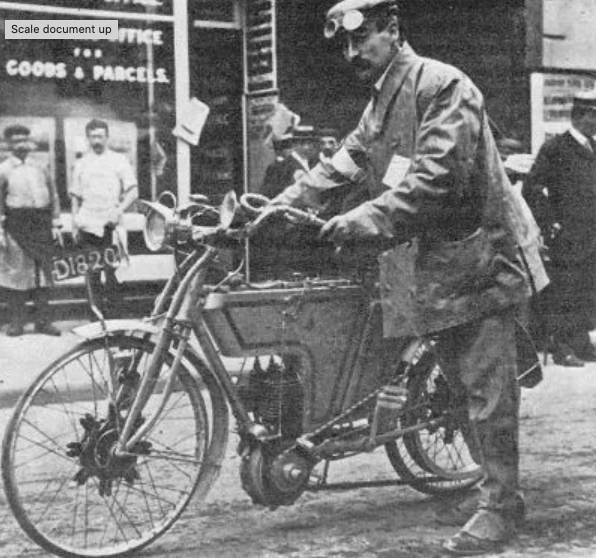
ROYAL ENFIELD ADOPTED the P&M two-speed set-up; Werner used a similar system with a rocking footchange.
HUMBER CEASED motor cycle production to concentrate on cars—but they’ll be back.
“THE DEFENDANT, ON THE OCCASION for which he was summoned, was riding a four-cylinder bicycle, which ‘gave bangs much more frequently than the ordinary cycle which had only one cylinder.’ Consequently it gave the impression of terrific speed while going at the same rate as the ordinary motor cycle. ‘Colonel Rowan Hamilton, JP— “I should get rid of that machine if I had it.” ‘Mr Devaynes Smith, JP—”Or alter it into a one-bang machine.”‘—From the report of the hearing of a speed-limit case in an Irish court.”
“KINGSTON MAGISTRATE: ‘WHAT DO you calL a police trap?’ Defendant: ‘A trap set by the police to catch motorists.’ Magistrate: ‘Then it is a motor trap. A trap set to catch rats is a rat-trap. This is not a police trap, because it is not used to catch the police. It is a motor trap.’ As the magistrate in question attempts to split hairs, we should like to point out that even ‘motor trap’ is not correct; it is the motorists who are trapped, not the motors.”
WILLIAM C CHADEAYNE, Captain of the Buffalo Motorcycle Club and a director of the Thomas Auto-Bi Company, rode one of the company’s bikes across the United States in 44 days, 23 hours and 50 minutes to set a transcontinental record. It was only the second coast-to-coast run; the first man to do it was George Wyman in 1903 [The full story is in the 1903 Features section]. Chadeayne’s Thomas Auto-Bi was a 2½hp 440cc single. He described the roads even east of the Mississippi as “unspeakably vile…seas of mud or oceans of sand” and was forced to ride along railway tracks for more than 600 miles.

FREDDIE BARNES JOINED Zenith as chief engineer and patented the Gradua variable-ratio belt drive transmission. It changed the effective diameter of the crankshaft pulley to alter the drive ratio, while simultaneously moving the rear wheel forward or back to maintain belt tension. Control was via a rotating lever on the fuel tank, The company was not shy of innovation, witness the Bicar, with hub-centre steering, two-speed transmission and a drum brake; it was based on the three-wheel Tricar. The Blue ‘Un reported: “Invented by Mr Tooley, of Great Yarmouth, and exhibited at the last Crystal Palace Show, where it made its debut, the Zenith Bicar is a completely novel form of motor-bicycle. The most interesting portion of the machine is, of course, the frame, which, as will be seen at once, is a startling departure from orthodox lines. The upper longitudinal tubes extend from the rear wheel spindles completely round the front wheel, the latter being supported in phosphor-bronze guides, in which it is allowed to move freely on hardened steel rollers. On each side of the front wheel spindle there are rods running to the steering arm, which are somewhat after the fashion of a tri-car one attached to the bottom of the steering pillar. The lower portion of the frame is hinged on two lugs which are brazed on to the forward end of the upper frame, while at the rear end shackles are fitted between the two portions. The back forks are of the usual pattern, but are hinged at the points where they converge on the rear spindle slots. The lower frame, therefore, carries the engine and coil and accumulator boxes, and the

weight of the rider, since the down tube is carried through a guide fixed on a lateral stay of the top frame, and attached to a similar stay on the bottom frame. Thus, to explain it clearly, the top frame carries the two wheels only, while the bottom frame supports the weight of the rider, engine, etc, independent movement of the two being allowed by the hinges and shackles to which reference has been already made. The advantages claimed are that vibration is considerably reduced, and by the novel system of steering employed the front forks-which are generally admitted to be the most vulnerable portion of the modern motor-bicycle-are done away with. Risk of sideslip also is, according to the makers, entirely eliminated. The motive power is a 3hp air-cooled [Fafnir] engine, governed by means of a variable inlet valve, while the gas is supplied to it through a latest pattern Longuemare carburetter. Particular attention has been paid to the ignition system, the current being supplied by two Prested accumulators, and intensified by a Prested trembler coil. Either accumulator may be put into action by using a neat two-way switch, which is fitted in a convenient position. A useful handlebar switch is also supplied, by means of which the current may be permanently cut off, or momentarily switched on and off at will for traffic riding. The belt is a Watawata, running on pulleys turned up to a correct angle. A free engine clutch is incorporated in the engine pulley, and a starting handle is supplied. After inspecting the machine at the Zenith Motor Engineering Co’s works at 101a, Stroud Green Road, Mr Bitton, the manager, kindly placed a machine at our disposal for a few minutes. The clutch took up the drive very nicely, and the engine easily started the machine from a standstill. Seated on 3 Brooks’ B100 saddle, and with our feet on comfortable footboards, we found the machine to be an easy-running and a satisfactory mount.”


BSA MADE ITS first motor-cycle, powered by Minerva; Minervas finished first, second and third in the 560-mile Sydney-to-Melbourne race.
SVANUS F BOWSER invented a petrol delivery pump. There’s eponymous for you.
THE USA PRODUCED 2,295 motor cycle, up from 159 in 1900. Among them was a new 4hp V-twin Orient .
BY YEAR’S END there were 21,521 motorcycles registered in Britain.
BRITISH IMPORTS OF motor cycles rose, to 1,700. Exports fell, to 688.
A GROUP OF enthusiasts met at the London Trocadero to set up the Automobile Association. Its prime aim was to help motorists avoid police speed traps.
THE SECOND RUNNING of the club team trial was a walkover for the MCC—no one else entered.
BICYCLING NEWS AND MOTOR REVIEW opined: “There is no disguising the fact that the motor-bicycle is, in England at least, under a cloud, many former riders of the same having given it up. Nor are the reasons for this state of affairs difficult to comprehend. Almost all manufacturers have, without rhyme or reason, taken the ordinary push-bicycle as their model for the vehicle, and tacked a motor to it somehow or other. As the fastenings turned out insecure, or the strain proved too much for the frame, or the space originally allowed showed itself to be too cramped, modifications have been introduced one by one, the maker being apparently content to get his conglomeration to hold together somehow, and wonderful contraptions have been the result. I don’t think it is too much to say that not a single one of the most popular—shall I not more truthfully say least unpopular?—models of to-day display features that a self-respecting designer of some six years back would have been ashamed to acknowledge as his own. Owing to—shall we say?—the want of mechanical thought, the small engine that, after all, did fairly well on the original motor-tricycles, and even on quads, has proved insufficient to take the bicycle with standard transmission along. Engine power has gone up, bringing in its train heavier framework and tyres, and speeds on the level that are far above the requirements of the average individual, without, however, always ensuring regular hill-climbing power…”


MOST OF THE motor cycle clubs springing up around the country were named for their home town; a small group of enthusiasts in Oxford showed more imagination, setting up a ‘semi-private’ club and calling it the Boanerges MCC. As biblical scholars will know, Boanerges was, allegedly, a nickname Jesus gave to his disciples John and James to reflect their fiery natures; it was later used to describe any ‘fire and brimstone’ preacher. So why use it for a bike club? Because it also translates as ‘sons of thunder’ and that’s how they were generally known (until they adopted the name Bocardo MCC a few years later). The Sons of Thunder MCC… clearly ahead of their time.
THERE WERE 20 STARTERS in the Circuit d’Ardennes. Entries included three Griffons ridden by messrs Lamberjack, Demeester and Bucquet; four Peugeots ridden by Cissac, Giuppone, Champoiseau and Riva and three Alcyons ridden by Anzani, Thomas and Griet. They faced three German Adlers and three Belgian Saroléas. The Griffon team stormed to victory with Bucquet, Lamberjack and Demeester finishing 1st, 2nd and 3rd. Thomas (Alcyon), battling Bucquet from the start, finished second, but his bike was found to be over the 50kg limit and was disqualified.

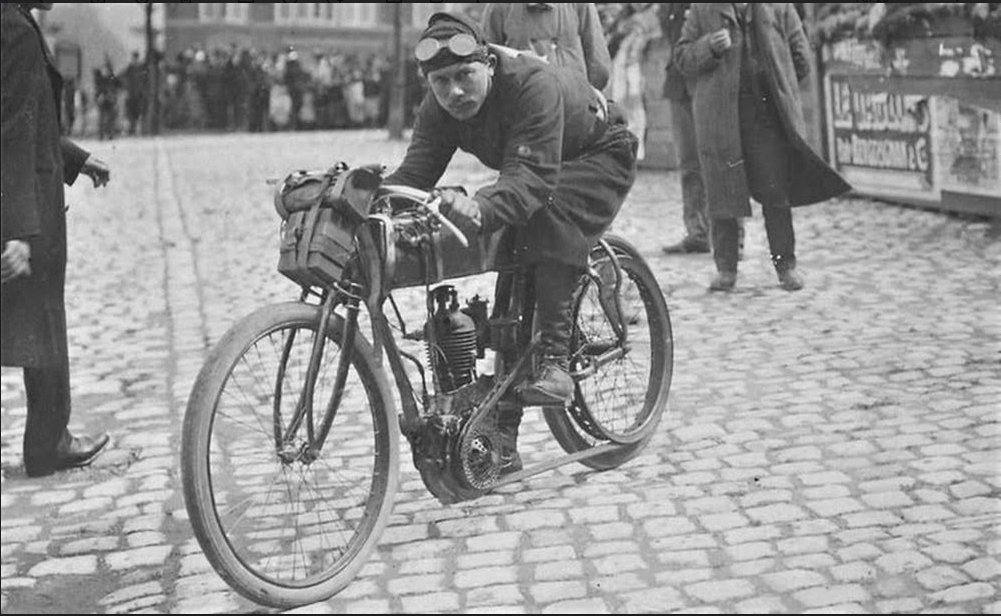
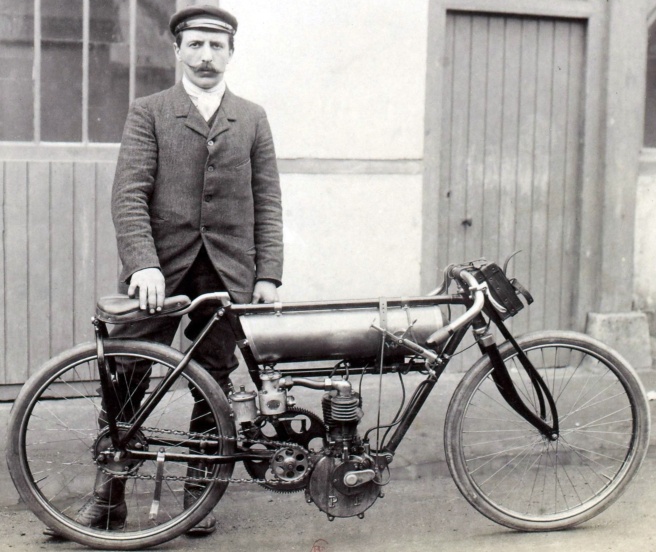
GIOVANNI PIRELLI DECIDED motor cycle races would be a great testbed for his tyres; their first outing was at the third Susa-Moncenisio race at Turin. The start was delayed by the late arrival of Queen Margherita who made up for it by donating a silver cup. There were 10 starters in the motor cycle class with the Peugeot team, Riva, Reale and Giuppone, firm favorite. Giuppone was leading when he ran out of petrol. He pushed his bike to the line leaving his team-mate Riva to win the cup presented by the magazine La Stampa Sportiva. However Giuppone ended the year on a high note. On 9 December he rode a 12hp twin Peugeot round the Parc des Princes track, covering 63 miles 1,078 yards in an hour to set a world record that would stand for three years (to save time slogging through 1908, the record breaker was Charlie Collier on, inevitable, a Matchless; he took the world record to 70 miles 105 yards in an hour).


STAGED AT MILAN FOR THE SECOND time by the magazine Gazzetta dello Sport, the Mille Kilometer Motor Competition, including the Brescia Cup race for motor cycles, was run over four 250km stages and coincided with the start of the Brescia Automobile Week, a major event on the European motor racing circuit with the prestigious Florio Cup at stake. Each manufacturer could enter a up to three machines. But breaking with standard Continental practice, they had to be fully equipped tourers of 3-4hp up to 475cc. Points were awarded for a range of factors including fuel consumption, reliability, durability, price and weight—and there was an average speed limit of 25km/h making this more like a long-distance trial than a road race. Teams were entered by Zedel, Neckarsulmer, Adler, Peugeot, Marchand, Primus and Stucchi; bikes started at one-minute intervals. Peugeot ended a long series of victories—all three bikes retired during the second stage with serious tyre problems. Marchand’s campaign ended when Morandi crashed and suffered serious head injuries. Stucchi, Neckarsulmer, Adler, Zedel and Primus all completed the course and, following a couple of weeks of deliberations, the judges declared Stucchi the winner, awarding the Brescia Cup to Stucchi teamster Pavesi.
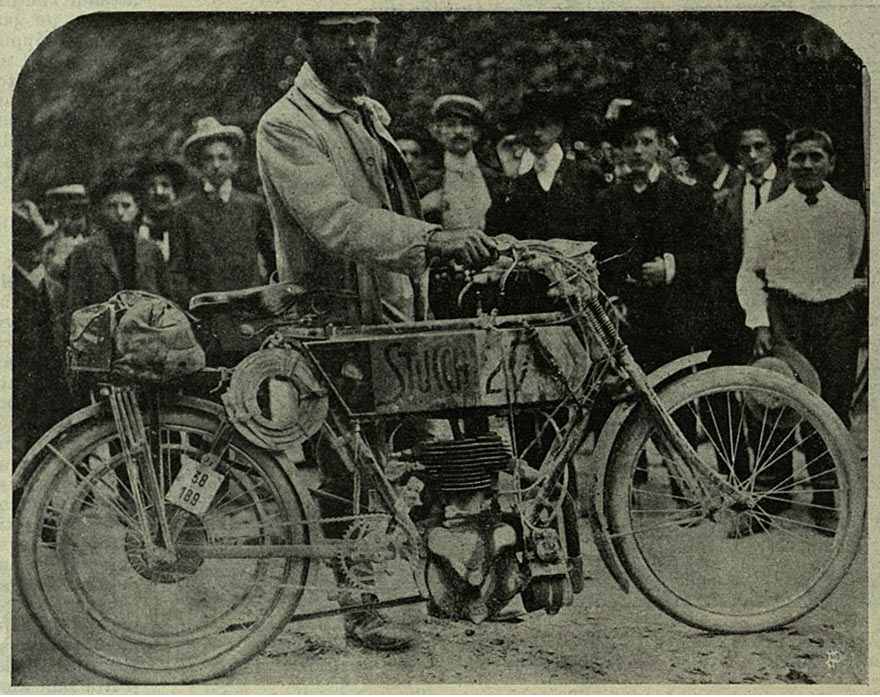
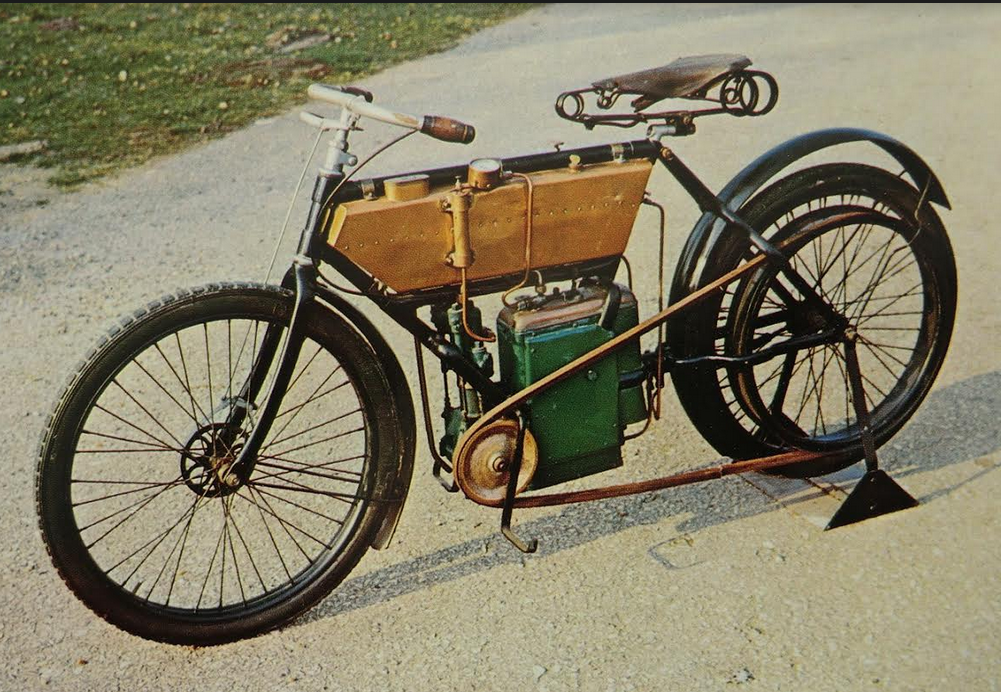
…and, for your delectation, here are a few of the ads that were tempting enthusiasts in 1905.

